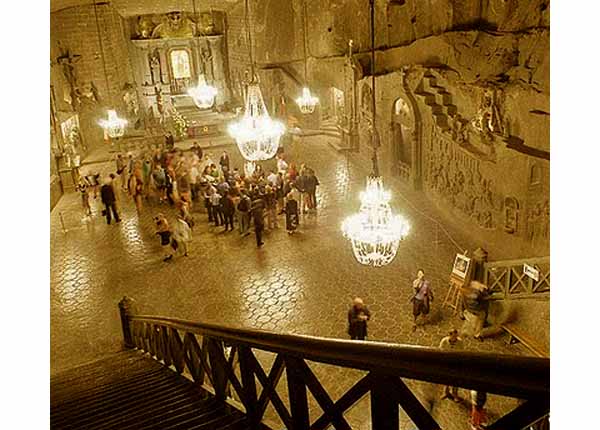
Photos from Kuriasitas website |
The visitors climb down the 378 steps of the carved stairway into a massive chamber with sculptured walls and gleaming chandeliers. Are they in some old medieval subterranean palace in Poland?
No, they are in one of the rooms many feet below the surface of the earth that make up the Wieliczka Salt Mines in a town on the southeast outskirts of Krakow. This mine, producing salt from the Middle Ages until 1996, is famous in Eastern Europe for the many wonders it contains. It is an underground world with churches, chapels and sculptures of biblical and mythic figures – all hewn out of solid rock salt. The winding labyrinth of pathways open into 2,000 large excavated chambers, although only some of these are open today to be viewed by awestruck visitors. The mine is often referred to as "the Underground Salt Cathedral of Poland."
Who were the draftsmen and artists employed for such a work? The history of the Wieliczka Salt Mine is quite different from that of modern monuments, where architects make detailed plans and professional sculptors are engaged to provide art works. This underground masterpiece was conceived and created by the miners from the Middle Ages to our days. The workers themselves hacked the rocks of salt from the mountain and transformed them into religious statues and historic scenes. Their only tools were their pickaxes and hammers. But the Catholic genius of the medieval age inspired the workers to take up those tools and transform their drab underground work place into a marvelous ensemble of works of art.
Traveling through the chambers of the Wieliczka salt mines, one understands more of that Catholic spirit that inspired the medieval miners and their successors until recently.
Foremost, it was a pious spirit. From the hands of these rough miners came beautiful churches and chapels, places to retreat amidst the hard labor, to give praise to Our Lord Jesus Christ and Our Lady. The largest and most magnificent of the more than 20 churches is the Cathedral; on its altar Masses were said and in its Tabernacle Our Lord resided.
The sculpted statues over the altar, the bas-relief wall figures, the communion rail - all are carved of salt. The rock salt is in various shades of grey so that the carvings resemble carved unpolished granite. Even the sparkling chandeliers are made of salt through a special process that removed all the impurities so it shined like crystal glass.
Many of the sculptures made by these simple labors depict biblical scenes that they were so familiar with – Christ teaching at the Temple, the Flight into Egypt, the Wedding Feast where Christ changed wine into water at the bequest of His Mother.
We also find the imaginative side of the Catholic man in these underground chambers. In the Janowice Chamber, the story of the origins of the mine is depicted. The pious Hungarian Princess Kinga, who later was raised to the altars, married Polish Prince Boleslaus the Chaste.
During a Mongol invasion of Poland, Kinga returned home to ask her father to help the distressed Poles. He gave her the salt mine of Máramaros, Transylvania, where she threw her ring into a shaft. Legend has it that the ring was found shortly afterwards in the first block of white sand dug in Wieliczkaa, mines so rich in deposits they came to provide a third of the income of the Polish Crown. Below, a miner is returning the ring to the medieval princess.
On other walls are knights engaged in battle, and a special chamber is dedicated to the 14th century warrior King Casimir the Great.
There are also 16 subterranean lakes in the mines, one with a ship docked on its salt shore. However, a catastrophic flood in 1992 ruined some of those chambers and made most of them unsafe sites.
Nine centuries of mining in Wieliczka produced a total of some 200 miles of passages as well as 2,040 caverns of varied size. In 1996 the mines finally closed, for practical reasons. The low price of salt on the market made it too expensive to extract it there and the mine was slowly flooding. Today visitors can take a two-mile tour in the oldest part of the salt mine and see 20 of these chambers, as well as a museum showing how salt was mined in the past.
But it is not the educational lessons on salt mining that attract the million visitors each year to the Wieliczka Mines. It is the marvelous work of the miners who breathed their Catholic spirit into their humble surroundings, creating a masterpiece that, like the medieval cathedral, has endured through the centuries.

Posted September 12, 2011

Related Topics of Interest
 Transient Marvels of Alaska Transient Marvels of Alaska
 The Sacral in the Rialto Bridge The Sacral in the Rialto Bridge
 The Elegance of the Alexander III Bridge The Elegance of the Alexander III Bridge
 Catholic Ambience in Lima’s Public Square Catholic Ambience in Lima’s Public Square
 The Appeal of the Stones at San Juan Capistrano The Appeal of the Stones at San Juan Capistrano
 Stained Glass: Light, Colors & Symbols Stained Glass: Light, Colors & Symbols

Related Works of Interest
|
|